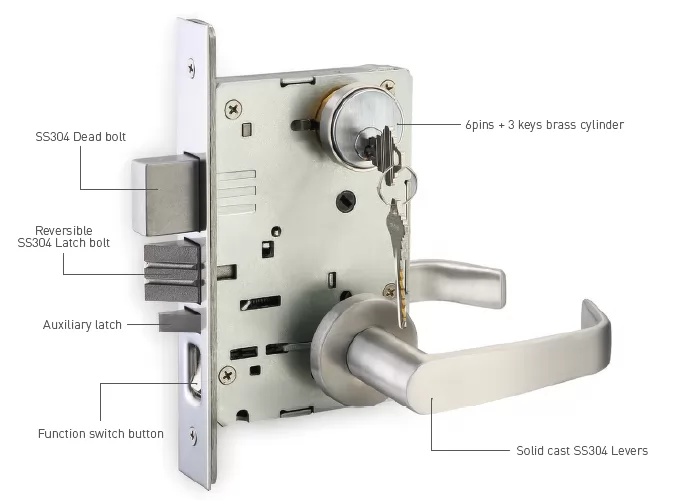What does a mortise lock with ANSI Grade mean?
The mortise is an aggregation of many different parts that are placed into a pocket in the door. Mortise lock are widely used in commercial buildings. The design of the mortise is meant to resistant to high traffic use and abuse. Normally, a mortise lock must be assembled around the pocket. And it includes the following parts
- Lock Body : The housing for the lock to work. The components that will disengage and engage the lock
- Lever/Knobs : The device to turn in order to retract the latch once the door is unlocked
- Spindle : The long rod that connects the handles through the door and lock body.
- Cylinder : A threaded cylinder that will rotate into the lock body. Mortise lock cylinder has a cam, which is a rotating rectangular piece of metal that manipulates the handle’s ability to retract the latch.

Understanding the grading system put in place by The American National Standards Institute (ANSI) is important.
When you see packaging or note bearing “ANSI Grade 3” or “2” or “1”, those numbers on door locks and deadbolts are a collaboration between ANSI and the Builders Hardware Manufacturers Association (BHMA). The expectation of locks to provide safety and stability is reflected in two main grades under the guidance of ANSI/BHMA A156.13, Operational Grade and Security Grade. The minimum acceptable grade level for both of these grades is grade 3, and assemblies, in the case of cylinders and other accessories, take the grade level of lowest graded component.
Grade 1
This is the highest level of ANSI grades for door locks. It is often reserved for locks intended for commercial security. But, these grade locks and deadbolts are also useful in some residential applications. Please note the difference between commercial and residential applications is not functional. It is more a matter of budget, legal requirements, and the owner’s willingness to invest in higher quality.
Grade 2
These locks are not expected to be as heavy-duty as Grade 1. Therefore, they may not be appropriate for many commercial applications.
Described as "light commercial," Grade 2 locks also exceed most apartment building requirements. They also exceed typical residential requirements. As a result, Grade 2 locks are not quite strong enough for most businesses. On the other hand, they offer more protection than common home locks.



